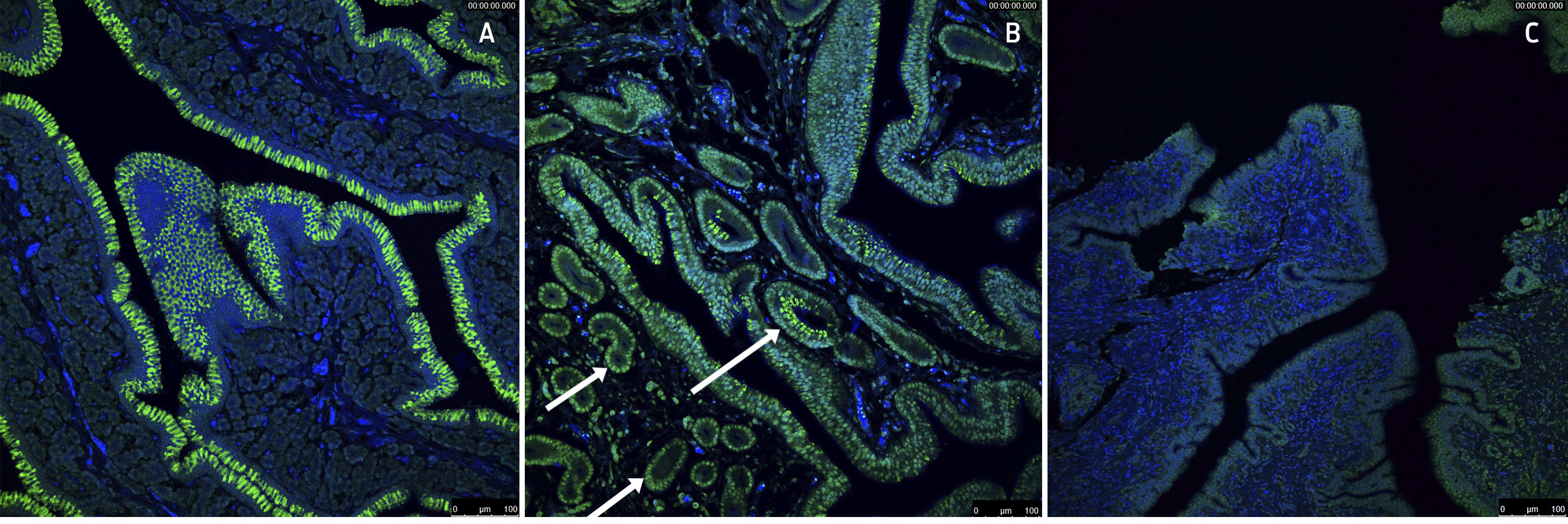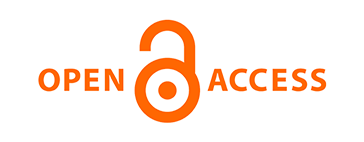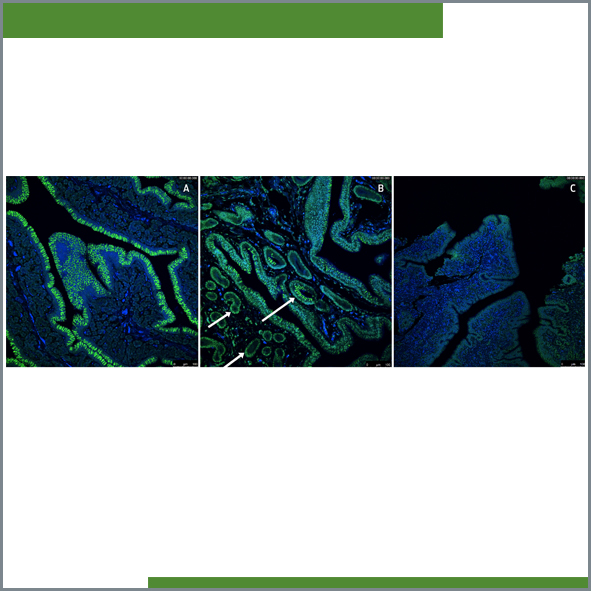Evaluation of the presence of avian influenza receptors in oviducts of forced moulting birds using immunofluorescence
Main Article Content
Abstract
Veterinaria México OA
ISSN: 2448-6760
Cite this as:
- Castillo Villanueva E, Sanchez Godoy F, Escorcia M. Evaluation of the presence of avian influenza receptors in oviducts of forced moulting birds using immunofluorescence. Veterinaria México OA. 2017;4(1). doi: 10.21753/vmoa.4.1.416.
During the 2012 highly pathogenic avian influenza outbreak in Mexico caused by the H7N3 subtype, infection led to the death of approximately 22 million laying hens. Thus, poultry farmers were faced with a challenge to ensure the continued commercial flow of eggs. In addition to implementing established sanitary protocols and vaccination programs, forced moulting management was utilized in the affected areas. This strategy guaranteed the maintenance of egg production in the quarantined areas by decreasing the mortality of the infected flock while re-stimulating egg production. To understand how forced moulting reduced mortality of the infected birds, we examined the distribution of the avian influenza receptor in the oviduct of hens subjected to forced moulting. We tested if changes in the reproductive tract caused by forced moulting generated a decrease in the expression of the specific virus receptor in the cell membranes. Host susceptibility to the influenza virus was determined by the presence of these specific receptors. We utilized immunofluorescence of the Maackia amurensis lectin to identify the presence of the virus receptor in histological sections of the oviducts of birds in egg production and birds undergoing forced moulting. The results showed the presence and distribution of the receptors for avian influenza. A strong signal of the receptor was observed in the histological sections of the oviducts of birds in egg production. Conversely, the signal was low in the oviducts of birds undergoing forced moulting. These results demonstrate a decrease in the number of receptors of birds subjected to forced moulting. A lack of receptors would affect virus infection and replication as well as virus-induced damage in the oviduct, which may help explain the observation in the field that birds infected with avian influenza and subjected to forced moulting have decreased mortality.

Article Details
References
Organización Mundial de la Salud Anima [OIE]. Update on avian influenza Paris, France: OIE; 2012 [Available from: www.oie.int/en/animal-health-in-the-world/update-on-avian-influenza/2012/.
Diario Oficial de la Federación. Acuerdo Sanitario para la Erradicación de Influenza Aviar de Alta Patogenicidad H7N3. In: SAGARPA, editor. México D F: Secretaría de Gobernación; 2013.
Organización Mundial de la Salud Animal [OIE]. Update on avian influenza Paris, France: OIE; 2013 [Available from: http://www.oie.int/es/sanidad-animal-en-el-mundo/actualizacion-sobre-la-influenza-aviar/2013/.
Kapczynski DR, Patin-Jackwood M, Guzman SG, Ricardez Y, Spackmen E, Bertran K, et al. Characterization of the 2012 highly pathogenic avian influenza H7N3 virus isolated from poultry in an outbreak in Mexico: Pathobiology and vaccine protection. J Virol. 2013;87(16):9086-96. doi:10.1128/JVI.00666-13.
Fouchier RA, Kawaoka Y, Cardona C, Compans RW, García-Sastre A, Govorkova EA, et al. Gain-of-function experiments on H7N9. Science. 2013;341(6146):612-3. doi:10.1126/science.341.6146.612.
Skehel JJ, Wiley DC. Receptor binding and membrane fusion in virus entry: The influenza hemagglutinin. Annu Rev Biochem. 2000;69:531-69. doi: 10.1146/annurev.biochem.69.1.531.
Sassaki GL, Elli S, Rudd TR, Macchi E, Yates EA, Naggi A, et al. Human (α2,6) and avian (α2,3) sialylated receptors of Influenza A virus show distinct conformations and dynamics in solution. Biochemistry. 2013;52:7217-30. doi:10.1021/bi400677n.
INEGI. Índice Nacional de Precios al Consumidor. In: Geografía INdEy, editor.México D. F.2016.
Sariözkan S, Güclü BK, Kara K, Gürcan S. Comparison of different molting methods and evaluation of the effects of postmolt diets supplemented with humate and carnitine on performance, egg quality, and profitability of laying hens. J App Poult Res. 2013;22(4):689-99. doi: 10.3382/japr.2012-00612.
Bell DD. Historical and current molting practices in the U.S. table egg industry. Poult Sci. 2003;82:965–70.
Organización Mundial de la Salud Animal [OIE]. Update on avian influenza Paris, France: OIE; 2016 [Available from: www.oie.int/en/animal-health-in-the-world/update-on-avian-influenza/2016/.
Facultad de Medicina Veterinaria y Zootecnia. Norma Oficial Mexicana. Especificaciones técnicas para la producción, cuidado y uso de los animales de laboratorio. México D F: Universidad Nacional Autónoma de México; 2014.
Prophet EB, Mills B, Arrington JB, Sobin LH. Laboratory Methods in Histotechnology (Armed Forces Institute of Pathology). Washington D C, USA: American Registry of Pathology; 1992. 279 p.
França M, Stallknecht DE, Howerth EW. Expression and distribution of sialic acid influenza virus receptors in wild birds. Avian Pathol. 2013;42(1):60-71. doi:10.1080/03079457.2012.759176.
Eroschenko VP, Wilson WO. Histological changes in the regressing reproductive organs of sexually mature male and female Japanese quail. Biol Reprod. 1974;11:168-79.
Wang JY, Chen ZL, Li CS, Cao X, Wang R, Tang C, et al. The distribution of sialic acid receptors of avian influenza virus in the reproductive tract of laying hens. Molecular and Cellular Probes. 2015;29:129-34. doi: 10.1016/j.mcp.2015.01.002.
García A, Johnson H, Srivastava DK, Jayawardene DA, Wehr DR, Webster RG. Efficacy of inactivated H5N2 influenza vaccines against lethal A/Chicken/Queretaro/19/95infection. Avian Dis. 1998;42(2):248-56.
License

Veterinaria México OA by Facultad de Medicina Veterinaria y Zootecnia - Universidad Nacional Autónoma de México is licensed under a Creative Commons Attribution 4.0 International Licence.
Based on a work at http://www.revistas.unam.mx
- All articles in Veterinaria México OA re published under the Creative Commons Attribution 4.0 Unported (CC-BY 4.0). With this license, authors retain copyright but allow any user to share, copy, distribute, transmit, adapt and make commercial use of the work, without needing to provide additional permission as long as appropriate attribution is made to the original author or source.
- By using this license, all Veterinaria México OAarticles meet or exceed all funder and institutional requirements for being considered Open Access.
- Authors cannot use copyrighted material within their article unless that material has also been made available under a similarly liberal license.



